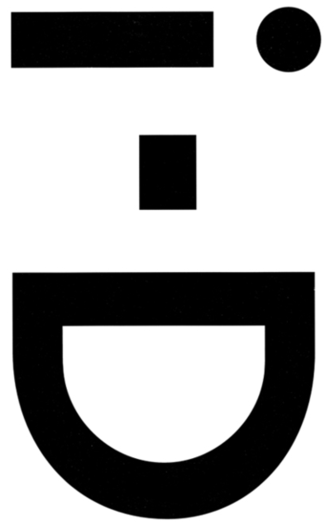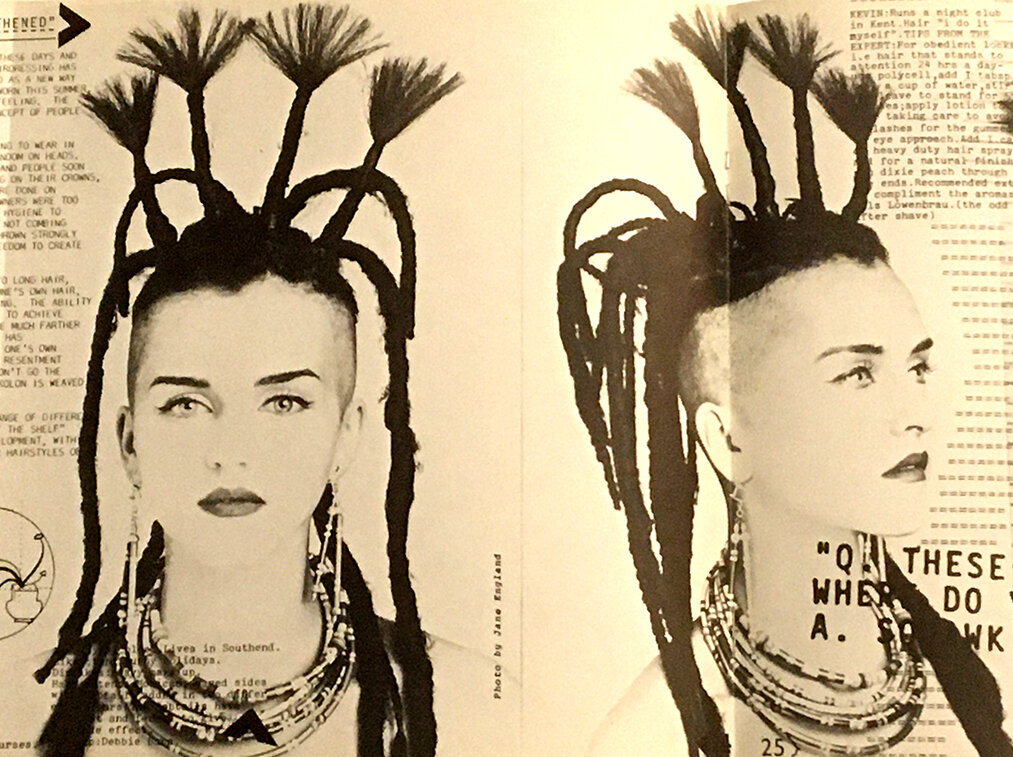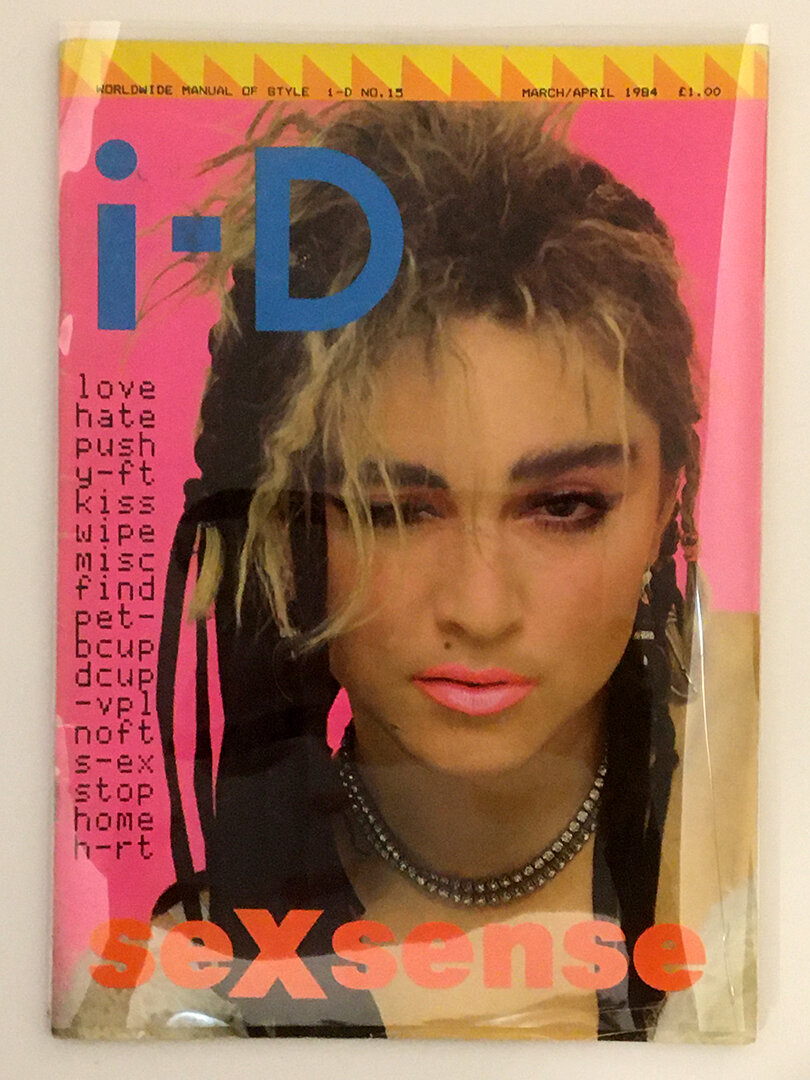Welcome to Archiviste XX. My name is Henrik I have curated, collected, + gathered these items on offer reflecting Cultural, Artistic, and Political Revolution from the past XX (20ème siècle/20th Century). I offer these to you.

Welcome to Archiviste XX. My name is Henrik I have curated, collected, + gathered these items on offer reflecting Cultural, Artistic, and Political Revolution from the past XX (20ème siècle/20th Century). I offer these to you.

i-D ‘was’ (in a purists sense as it spans 2 to 3 generations of Cool- 40 years), though still published as a British monthly magazine, dedicated to the emerging scenes of Punk/Post-Punk Britain. Street Fashion, Music, art and Youth Culture. i-D was founded by designer and former Vogue art director Terry Jones in 1980. The first issue was published in June 1980 as a hand-stapled fanzine with text produced on a typewriter and a collage style that was DIY without any pretense to a ‘style’ whilst documenting ‘style’. i-D is now a glossy fashion tool but still retains a little bit of ‘edge’. The magazine featured in early issues the hybrid style of documentary/fashion photography called ‘The Straight Up’. At first, these were of punks and new wave youth found on English streets and who were simply asked ‘Straight up’ who did your hair, where did you buy the clothes, who were you or aspiring to be placed up against a wall and photoed.
This before the communication of the ‘internet’ i-D was a global communication window/tool into scenes in London, Paris, NYC, Los Angeles, Berlin, and Tokyo. Anticipation for the new issue was like Christmas it was edge it was straight no chaser beyond ‘straight up’. These issues were necessary to be informed culturally (Street Fashion, Music, and all). Punks, Dreads, New Romantics, Mods, Hip-hop, Disco, House, Gay and all scenes were introduced to the world in these pages. We see young Boy George saying he wants to be a singer or we are introduced to a London ‘Buffalo Style’ by way of Malcolm McClaren. It was aspirational and confirming that you were not alone in being ‘different’ (however the individual defined that).
All issues presented here are for sale. Issue N°1 separately and issues N°2-15 (as a lot). Please write for all quotes and queries!

Tipped on its side, the "i-D" typographic is a biomorphic logo revealing a winking smiley face. Most issues of
i-D have featured a winking cover model.
i-D N°1 Summer 1980. Original & MINT !

This exhibit relates to our previous Exhibit 02: Disco via Fiorucci. i-D’s relationship with Fiorucci started early on as one of its first advertisers/supporters. Obviously i-D is a Fashion Magazine (As it states on it premiere issue and those after), though this is blurred to great effect. As such, i-D was in pursuit of street cred but clearly knew the importance of commerce, Fashion commerce. Especially in context to i-D’s founder Terry Jones background, as he worked for British Vogue, Vanity Fair, and Italy’s Donna Magazine. In early issues, Record labels aren’t advertising but ‘Fashion’ exclusively so from Fiorucci to Portobello Market stall vendors. i-D’s (Terry Jones) relationship with Fiorucci and it’s founder Elio Fiorucci would be long lasting as the pair met through photographer Oliviero Toscani in 1977. As Terry states “After I started i-D, we were struggling with distribution, and in 1983 Elio came on board as a global distributor. At the same time he asked if I would be Fiorucci’s Creative Director. So then he (Elio) became a major client…that was a crucial year in terms of whether or not I was going to survive”.

Letter from Terry Jones to Elio Fiorucci c.1992.

i-D N°2. Winter 1980.

i-D N°3. The i-Deye issue. Winter 1981.
From the content of issues N°1-3 we see the Punk uniform is giving way to something new from Punk- The New Romantic. We see adverts for the first time from Record Companies for bands like Spandau Ballet & Duran Duran both New Romantic founders. London’s Club scene is burgeoning with Characters like Marilyn, Boy George, and Scarlett. London is moving into its ‘Post-Modern’ invention. George (Boy George) in issue N°3 (1981) is quoted as saying “…I think i’m the best thing that ever happened to the World…”. George is in a band called ‘In praise of Lemmings’. Issue N°3 now has one page for front & back whereas N°1 + 2 were all single sheets stapled. One of the first steps towards a full colour and full size Magazine we know of Today. Of course this represents success amongst readers and more money. Graphically it’s becoming more defined through typography and layout.

i-D N°4. The Dance and Stance issue. Summer 1982.

i-D N°5. The do it yourself issue. 1981.

i-D N°6. The sweat is best issue. 1981. Model: Jones.
BOOM Bastic Bold i-D Worldwide !!! From content N°4-6 we now have a defined graphic style. Two colour pages/ B&W pages have been replaced by multi-colour pages along with B&W graphics that still convey Scene, Internationalism, Fashion, and the ‘Anti’. On the issue N°5 cover we have the first face and personality- Lady Diana Spencer! Story content has more depth and issues have titles, its local (London DJ Princess Julia dancing at Holy City Zoo on Saturday, N°6) whilst combing scene reportage from Paris, NYC, and Japan. Ads are still local (Kensington Market vendors, etc.) and Record labels. From the first issue the price has increased 25p from 50p to 75p ($1.50 c. 1981). Remember English Society is based heavily on class structure. We see remnants of Punk which was reaction/attempted destruction of these rules to English Society as we see in the deconstruction of Lady Diana in issue N°5. The constant juxtaposition of Black, Gay, Poor, White youth against posh Fashionista’s as equals- Sartorially speaking.

i-D N°7. The In future issue. 1982. Model: Kate.

i-D N° 8. The Head to Toes Issue. 1982. Model: Scarlett.

i-D N° 8. The Head to Toes Issue. 1982. Model: Scarlett.
Again in London, the special relationship with i-D, which saw founder Terry Jones act as Fiorucci's art director and Elio Fiorucci as the magazine's principal sponsor, resulted in the production of special Fiorucci–only editions. Exampled by the edition N°8 with model Scarlet. Two editions were made one for i-D at large distribution and Fiorucci distribution both signifying London, Underground, and Youth culture that was at a forefront of communication sans internet. i-D proved again 3-4 years after founding it was the defining communication of cool internationally via Fotos, Music, Fashion, and attitude.

Image from The book Fiorucci by Rizzoli.

i-D N° 9. The Wuli Dancing issue. 1982.

i-D N° 10. The Out Already issue. 1982. Model: Moira Bogue.
i-D issue N°10 is special for me as it was my first i-D Magazine that I purchased which was expensive in Sweden and that my eyes exploded opon. Meaning it was a revelation of a philosophy that said I belonged to a tribe that was not local but international. I was saved! At the same time I fell in love with a model who signified Music (Bauhaus, Joy Division, Dr. Alimantado, and The Eurythmics), Style, and just plain Sexiness. She will forever be unknown as The page layout text is Black placed on Black so ts unreadable (40 years an unknown lovers name)! As well the issue is a continuum/progression towards its inevitable- a glossy. Advertising within the pages are a coterie of British and the Worldly Avant-garde: Katharine Hamnett, Issey Miyake, Body Map, and more.

A lovely Post-Modern Beauty.

i-D N°11. The Health and Herpes Issue. 1983. Model: Fiona Skinner.

i-D N°12. The Love and Romance Issue. 1983. Model: Sophie.
With i-D Magazine N°12 and N°13 the magazine is three years in, in this short time Punk was dominant then the birth of Post-Punk (Goth, New Romantics, Synth-Pop, and New Wave). i-D was there documenting every progression within in its pages locally & World wide. As such, it’s a Sociological document of dare I say a ‘bygone era’. These scenes were created by children of a Cold War. The Club life which i-D documents was defined by ‘costume’ not Pound or Dollar. The driving force to all these scenes was an explosion of Music on all fronts coming from Britain and the USA. Soon Disco re-emerges in the form of House Music. Fashion from the streets soon begin to take over the runways with the likes of Jean-Paul Gaultier, Vivienne Westwood, Katharine Hamnett, and others.
With bold graphics and great Cult like following the advertisers came easily we begin to see UK National and International brands. Again, with a new infusion of money by Fiorucci’s sponsorship and distribution the content is bolder via graphics which attracts other Brands to advertise with i-D and more readership.
Lest we not forget i-D was more than a ‘Magazine’ it was a mode of Communication across the channel, across the Pond, and across all borders. This was not exclusive as English Magazines The Face and Blitz also did service. But i-D always kept the all important blur of Street and glossy. High and low. It defined cool. It spoke to the many creatives that they were not alone. The only other comparable mode of Communication was the Vinyl LP. Those 12 inches with the jacket was a window into other realms and possibilities that drove and made the heart rate increase- so did i-D. I myself from a small town dreamed of going to London, Paris, or NYC to experience this- The Youth Revolution. Nothing less than a Youth Revolution!

i-D N°13. The Wet’n’Wild Issue. 1983. Model: L.A.
David Owen (IDEA books co-founder): And there was a real cross-pollination of ideas between i-D and Fiorucci?
Terry Jones (i-D Magazine founder): The Panini sticker book was the big project for Fiorucci, and then catalogues and posters. I asked Nick Knight to do three posters. That was very early on in Nick's career. I was inspired by James Bond titles — the starting point in a psychedelic mix. We did those and then one pure one with a girl who had just been on the cover. And then Mark Lebon was one of our contributors. We would produce a double page for Fiorucci for i-D and would have the budget to do it in a studio. I had been speaking with Madonna's agent after she performed at a Fiorucci party in Paris — she just came down while we were doing the Fiorucci spread and no one knew who she was. She was just a club girl. So she appeared in the Sade cover issue and then had her own cover the following issue. That spontaneity was great.

i-D N°14. The All Star Issue. 1983. Model: Sade. Foto: Nick Knight.

i-D N°15. The seXsense Issue. 1984. Model: Madonna. Foto: Mark Lebon.
Through these pages from 1980-1984 we witness an intense cultural progression of late 20th Century Fashion, Style, and rebellion. As in all history so much can be gleaned from it as it informs us of past, present, and future. As such, Fashion, Art, Design it’s what informs us and guides us even through times of pestilence. Music stars, Fashion stars, Club stars, and Street stars rule supreme as it should always be that way. Youth owns the streets and in this period they made it internationally glorious!
As stated in i-D N°1 “…I.D. Is a Fashion/Style Magazine. Style isn’t what but how you wear clothes. Fashion is the way you walk, talk, dance, and prance. Through I.D. ideas travel fast and free of the mainstream - so join us on the run!…”
All issues presented here are for sale. Issue N°1 separately and issues N°2-15 (as a lot). Please write for all quotes and queries!